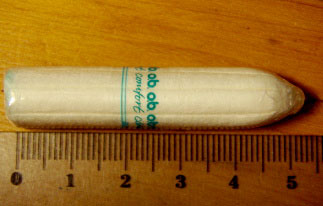
Mother Jones illustration; Getty
Until last week, no study had ever been published that tested period products—tampons, pads, discs, cups, and underwear—using human blood. A team of four women just changed that.
On August 7, Dr. Bethany Samuelson Bannow and a group at Oregon Health & Science University in Portland released a study to test saturation and capacity levels in menstrual products in hopes of better understanding how to diagnose heavy menstrual bleeding, or HMB, which impacts millions of Americans.
Why had it taken so long to test a product made to contain human blood with human blood? “I think with women’s health, including menstrual health, we’ve been a little bit behind the eight ball,” Dr. Bannow told me. “They didn’t even require women to be included in NIH studies until 1993. I think that that’s telling of what we prioritize as a society.”
Providers trying to diagnose HMB depend on self-reporting, which can be subjective with people falling prey to myths and miseducation. A patient experiencing pain, fatigue, or other related symptoms will come in and ask: Is this normal? To tell if the bleeding is excessive, doctors try to ascertain how many period products are used per hour. But measurement is imperfect. Menstruators change out products for tons of reasons; and products may claim they can sustain a certain amount of “flow,” but their actual capacity is different. That is what Dr. Bannow hoped to make clear in her testing.
The team took 21 different products and saturated or filled them with expired human-packed red blood cells. This isn’t an exact match to menstrual blood—which has clots and secretions—but it’s a lot closer than salty water. In their research, they found that how the companies were labeling the boxes did not match up with their results. The majority of menstrual products reported that they had greater capacity than the testing found.
“[There is a] disconnect between who’s making the products and what their goals are, and those of us who are using them as a diagnostic method,” said Dr. Bannow, a hematologist who works with HMB patients, “I think [that] plays a role” in this being the first study to use human blood.
Dr. Bannow and I spoke about their research, its implications, and how the stigma about period blood continues to stifle care.
Could you tell me a bit about how you learned or found out that no studies testing period products with human blood had been published?
In anticipation of another study, we did a little bit of a deep dive into the literature trying to figure out how much different period products should absorb. And that’s when I learned about The Tampon Task Force from the 80s. [Editor’s note: At the request of the Food and Drug Administration, industry leaders and other stakeholders convened as part of The Tampon Task Force in 1982 to create standardization across their products.] The FDA and The Tampon Task Force really set the standard of saline being the liquid used to test menstrual products. We really couldn’t find anything in the literature about using blood. A researcher named Nancy Reame reportedly tried heparinized blood, but the data wasn’t ever published. That’s when we sort of realized that this is an important frame that’s missing!
How has the diagnosis and treatment process been complicated in the past by different understandings of absorption and saturation of period products?
So there are two main sets of objective criteria that we can consider using for diagnosing heavy menstrual bleeding. The first is a great tool called the pictorial blood loss assessment chart, or PBAC, which has folks document their pads and tampons used over a cycle and how saturated they are. And then the other is just taking an in-office history, which also relies on pads and tampons. Typically, anybody who changes a pad or tampon more often than every two hours probably has HMB. But it’s all dependent on pads and tampons. This testing is all multiple decades old. Modern technology is so much better. I think we’ve been grossly underestimating HMB based on these old data and methods.
It’s remarkable that there’s no across-the-board standard for these products. At the same time, it seems like these companies were misrepresenting the absorption or saturation levels. Is that what you all found?
I wouldn’t go so far as to say they’re misrepresenting. We found something different than they did when using a different substance than they did.
If I was testing somebody for diabetes, I have instruments in a lab, or in my office, that are standardized. When it comes to periods, we’re dependent on using these products that weren’t created with the goal of diagnosing HMB in mind. They’re created to help somebody who’s menstruating manage their periods. I think the bottom line isn’t so much that companies need to standardize things as we need to be aware as physicians and other health care providers just how much these products can hold.
My friends are talking about switching from tampons and pads to alternative products like cups and discs. You note in the study that you’ve seen this as well in practice.
Yes!
What do you think this shift will mean for the diagnosis and treatment of HMB and other conditions?
Honestly, I think it’s gonna be better. The menstrual cups report the volume that it takes to fill them. The volume is the volume is the volume. I think it actually has the potential to make things a lot easier and more straightforward.
A lot of the language that we use around menstrual bleeding is really vague. Even on these products’ websites, it’s talking about if your flow is light or medium. As a menstruator, I don’t really know what that means. Have you seen this vague language with your patients?
It’s very vague, and it’s also very subjective. For example, I’ll have families of patients where all the periods are heavy. They’ll say, Oh, my periods are totally normal. Then I talk to them, and they’re filling a menstrual cup every two hours, and that’s definitely not normal. That’s why we need studies like the one that we did here. We thought it was so important to get something objective.
The statistics say that probably about a third of folks who menstruate will have HMB at some point in their lives. And I think certainly fewer than a third of menstruating folks are treated and evaluated for HMB. There’s a big disparity there. Also, when we first start menstruating, and then towards the end of menstruation, periods can be extra heavy during those times. Those are perhaps the times that we as a society talk about the least: puberty and menopause.
Using human blood in these studies, then, could help patients and providers?
I think using human blood is going to be better and more accurate than using saline. That said, menstrual blood is more than just the red blood cells we used. It includes other secretions and endometrial cells and it varies tremendously between people and between days of cycle. So, there’s never going to be perfect standardization. We think our method is better, of course, but we also acknowledge that there’s limitations to it.
How are menstruators going to be impacted in the future by this study, and having more accurate knowledge of what the products they use for their periods really do?
I want to be very clear, we did not decide at the end of this study that any menstrual product was best for anything. It’s a highly individual decision. I don’t think that we do or really should choose products based on how many milliliters of blood they contain. There are so many more individual reasons to prefer one product over another. Social media has focused on maybe some products not being as absorptive as they reported, and I understand that frustration. But I don’t think it’s a main point that we were trying to get at.
What I hope this changes is the conversation that doctors have with patients. We were really just trying to make sure that nobody has a diagnosis of HMB missed because doctors don’t realize that their period products are absorbing so much blood. I just want people to know that there are a ton of options for treating HMB. People really shouldn’t have to suffer with that.
This interview has been edited for length and clarity.








